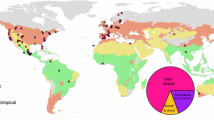Abstract
More than 25 years have passed since publication of the first comprehensive multi-authored landmark volume on the population biology and evolution of clonal organisms (Jackson et al. 1985). Since then, no less than eight symposium volumes or special issues have appeared in scientific journals reporting on advances in the field of clonal plant research, indicating that the study of clonal organisms has remained an important topic in ecological research. The three most recent overviews were published in special issues of this journal (Stuefer et al. 2000; Tolvanen et al. 2004; Sammul et al. 2008), and these are now supplemented with a fourth special issue of Evolutionary Ecology. The articles published here reflect some of the most important contributions to a workshop on clonal plant biology held in Leuven (Belgium) in July 2009 and they illustrate some major advances that have been made over the last few years. In the following paragraphs, we first summarize some representative contributions to the current issue, and second, we put forward some personal ideas about promising and underexplored research lines in clonal plant research.
Similar content being viewed by others
References
Arnaud-Haond S, Alberto F, Teixeira S et al (2005) Assessing genetic diversity in clonal organisms: low diversity or low resolution? Combining power and cost efficiency in selecting markers. J Hered 96:1–7
Bierzychudek P, Eckhart V (1988) Spatial segregation of the sexes of dioecious plants. Am Nat 132:34–43
Bonin A, Bellemain E, Bronken-Eidesen P et al (2004) How to track and assess genotyping errors in population genetics studies? Mol Ecol 13:3261–3273
Charpentier A (2002) Consequences of clonal growth for plant mating. Evol Ecol 15:521–530
de Kroon H, van Groenendael J (eds) (1997) The ecology and evolution of clonal plants. Backhuys Publishers Leiden, The Netherlands
Eckert CG (1999) Clonal plant research: proliferation, integration but not much evolution. Am J Bot 86:1649–1654
Eckert CG (2000) Contributions of autogamy and geitonogamy to self-fertilization in a mass-flowering, clonal plant. Ecology 81:532–542
Handel SN (1985) The intrusion of clonal growth patterns on plant breeding systems. Am Nat 125:367–384
Honnay O, Jacquemyn H (2008) A meta-analysis of the relation between mating system, growth form and genotypic diversity in clonal plant species. Evol Ecol 22:299–312
Hutchings MJ, Wijesinghe DK (2008) Performance of a clonal species in patchy environments: effects of environmental context on yield at local and whole-plant scales. Evol Ecol 22:313–324
Jablonka E, Raz G (2009) Transgenerational epigenetic inheritance: prevalence, mechanisms, and implications for the study of heredity and evolution. Quart Rev Biol 84:131–176
Jackson JBC, Buss LW, Cook RE (eds) (1985) Population biology and evolution of clonal organisms. Yale University Press, Newhaven
Klimes L, Klimesova J, Hendriks R (1997) Clonal plant architecture: a comparative analysis of form and function. In: de Kroon H, van Groenendael J et al (eds) The ecology and evolution of clonal plants. Backhuys Publishers Leiden, The Netherlands, pp 1–29
Liu J, Dong M, Miao SL et al (2006) Invasive alien plants in China: role of clonality and geographical origin. Biol Invasions 8:146–147
O’Brien EE, Brown JS, Moll JD (2007) Roots in space: a spatially explicit model for below ground competition in plants. Proc R Soc Lond B Biol Sci 274:929–934
Pysek P, Jarosik V, Pergl J et al (2009) The global invasion success of central European plants is related to distribution characteristics in their native range and species traits. Diversity Distrib 15:891–903
Sammul M, Kull T, Kull K et al (2008) Generality, specificity and diversity of clonal plant research. Evol Ecol 22:273–277
Silander JA (1985) Microevolution in clonal plants. In: Jackson JBC, Buss LS, Cook RE (eds) Population biology and evolution of clonal organisms. Yale University Press, New Haven, pp 107–152
Silvertown J (2008) The evolutionary maintenance of sexual reproduction: evidence from the ecological distribution of asexual reproduction in clonal plants. Int J Plant Sci 169:157–168
Stuefer J, Erschbamer B, Huber H et al (2000) The ecology and evolutionary biology of clonal plants: an introduction to the proceedings of Clone-2000. Evol Ecol 15:223–230
Tolvanen A, Siikamaki P, Mutikainen P (2004) Population biology of clonal plants: foreword to the proceedings from the 7th Clonal Plant Workshop. Evol Ecol 18:403–408
Vallejo-Marín M, O’Brien HE (2007) Correlated evolution of self-incompatibility and clonal reproduction in Solanum. New Phyt 173:415–421
Vallejo-Marín M, Dorken ME, Barrett SCH (2010) The ecological and evolutionary consequences of clonality for plant mating. Ann Rev Ecol Syst 41 (in press)
Vandepitte K, Roldán-Ruiz I, Leus L et al (2009) Canopy closure shapes clonal diversity and fine-scale genetic structure in the dioecious understorey perennial Mercurialis perennis. J Ecol 97:404–414
Vekemans X, Hardy OJ (2004) New insights from fine-scale spatial genetic structure analyses in plant populations. Mol Ecol 13:921–935
Vilà M, Basnou C, Pyšek P et al (2010) How well do we understand the impacts of alien species on ecosystem services? A pan-European cross-taxa assessment. Front Ecol Environ 8:135–144
Acknowledgments
We would like to thank all participants of the Clonal Plant Workshop in Leuven 2009 for presenting and discussing current themes in clonal plant research. Josef Stuefer kindly agreed with a SI of Evolutionary Ecology on clonal plant species. Special thanks are due to Tine Meekers, Koen de Hert, Tobias Ceulemans, Katrien Vandepitte, Filip Vandelook, Edgar Gareca Leon and especially Christa De Troeyer for help in organizing this meeting. This paper benefited from insightful comments of Mike Hutchings and Katrien Vandepitte. The Flemish Fund for Scientific Research (FWO) kindly sponsored the organization of the workshop.
Author information
Authors and Affiliations
Corresponding author
Rights and permissions
About this article
Cite this article
Honnay, O., Jacquemyn, H. Clonal plants: beyond the patterns—ecological and evolutionary dynamics of asexual reproduction. Evol Ecol 24, 1393–1397 (2010). https://doi.org/10.1007/s10682-010-9408-z
Received:
Accepted:
Published:
Issue Date:
DOI: https://doi.org/10.1007/s10682-010-9408-z




